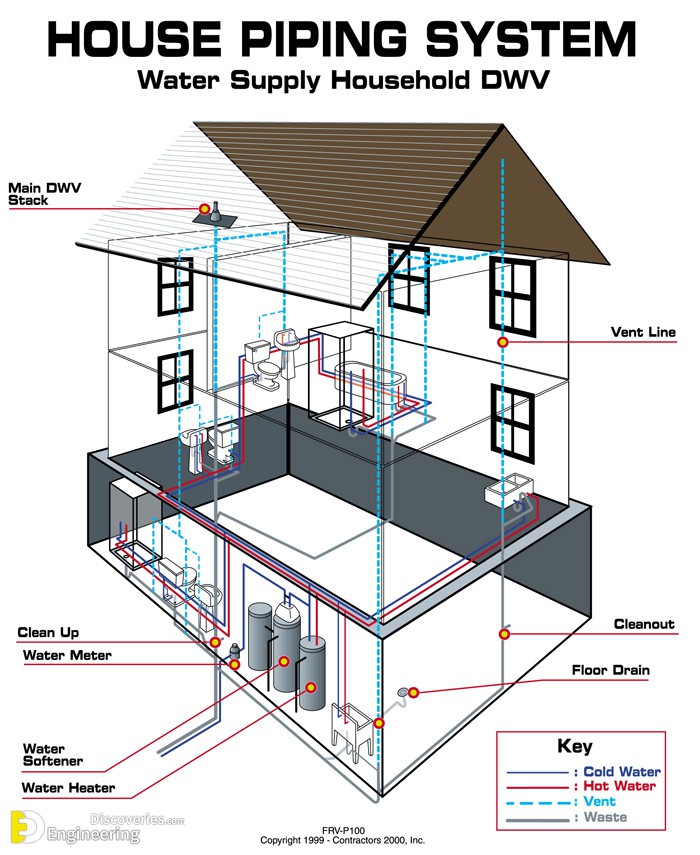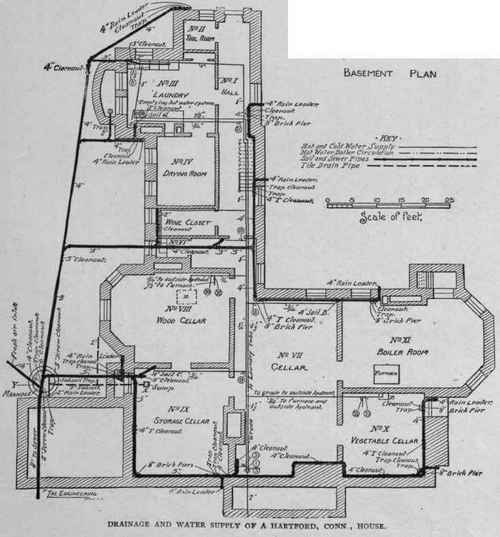Examining Your Property's Plumbing System Anatomy
Examining Your Property's Plumbing System Anatomy
Blog Article
This article listed below relating to The Inner Workings of Your Home's Plumbing is indeed interesting. You should take a look.

Understanding just how your home's plumbing system works is vital for every property owner. From providing clean water for drinking, cooking, and showering to securely removing wastewater, a well-maintained plumbing system is vital for your family members's wellness and convenience. In this detailed guide, we'll check out the elaborate network that makes up your home's plumbing and offer pointers on maintenance, upgrades, and managing usual issues.
Intro
Your home's pipes system is greater than simply a network of pipelines; it's an intricate system that ensures you have accessibility to clean water and efficient wastewater removal. Understanding its elements and how they work together can help you avoid costly repairs and make sure whatever runs smoothly.
Basic Components of a Pipes System
Pipelines and Tubing
At the heart of your plumbing system are the pipes and tubing that bring water throughout your home. These can be made of different materials such as copper, PVC, or PEX, each with its benefits in terms of longevity and cost-effectiveness.
Components: Sinks, Toilets, Showers, and so on.
Fixtures like sinks, toilets, showers, and bathtubs are where water is used in your house. Comprehending just how these fixtures attach to the pipes system aids in diagnosing troubles and preparing upgrades.
Valves and Shut-off Factors
Valves manage the flow of water in your pipes system. Shut-off valves are crucial throughout emergency situations or when you need to make fixings, enabling you to isolate parts of the system without interfering with water flow to the whole home.
Water Supply System
Key Water Line
The primary water line attaches your home to the local supply of water or a private well. It's where water enters your home and is distributed to various components.
Water Meter and Pressure Regulatory Authority
The water meter actions your water usage, while a pressure regulatory authority ensures that water moves at a secure pressure throughout your home's pipes system, avoiding damage to pipes and components.
Cold Water vs. Hot Water Lines
Recognizing the distinction in between cold water lines, which provide water directly from the primary, and warm water lines, which carry warmed water from the water heater, assists in repairing and planning for upgrades.
Drain System
Drain Pipes Pipeline and Traps
Drain pipelines lug wastewater away from sinks, showers, and bathrooms to the drain or septic tank. Catches prevent sewage system gases from entering your home and additionally trap particles that might cause obstructions.
Air flow Pipes
Ventilation pipelines allow air into the drain system, protecting against suction that might reduce drainage and cause traps to empty. Correct ventilation is necessary for maintaining the integrity of your plumbing system.
Value of Appropriate Water Drainage
Ensuring proper drain prevents backups and water damages. Consistently cleaning up drains and preserving traps can stop expensive repair services and prolong the life of your pipes system.
Water Heater
Sorts Of Hot Water Heater
Hot water heater can be tankless or standard tank-style. Tankless heating systems heat water on demand, while tanks store warmed water for prompt usage.
Exactly How Water Heaters Connect to the Plumbing System
Recognizing just how hot water heater link to both the cold water supply and hot water distribution lines helps in diagnosing issues like insufficient hot water or leakages.
Maintenance Tips for Water Heaters
Frequently purging your water heater to eliminate debris, checking the temperature settings, and evaluating for leaks can expand its life-span and improve power effectiveness.
Usual Plumbing Problems
Leaks and Their Causes
Leakages can happen due to maturing pipelines, loosened installations, or high water stress. Addressing leakages without delay avoids water damage and mold development.
Obstructions and Obstructions
Blockages in drains pipes and bathrooms are commonly triggered by flushing non-flushable items or an accumulation of grease and hair. Making use of drainpipe screens and being mindful of what goes down your drains can prevent blockages.
Signs of Plumbing Issues to Watch For
Low tide pressure, slow-moving drains, foul odors, or uncommonly high water bills are indications of prospective plumbing issues that must be attended to quickly.
Plumbing Maintenance Tips
Regular Examinations and Checks
Arrange yearly pipes assessments to catch concerns early. Try to find signs of leaks, rust, or mineral accumulation in taps and showerheads.
DIY Upkeep Tasks
Easy jobs like cleansing faucet aerators, looking for commode leaks utilizing dye tablets, or shielding revealed pipes in chilly environments can avoid significant plumbing concerns.
When to Call a Specialist Plumbing
Know when a pipes problem requires expert experience. Attempting complicated repair work without correct knowledge can cause even more damage and higher repair work prices.
Upgrading Your Pipes System
Factors for Upgrading
Upgrading to water-efficient fixtures or changing old pipelines can improve water high quality, reduce water bills, and boost the value of your home.
Modern Plumbing Technologies and Their Benefits
Check out innovations like clever leak detectors, water-saving toilets, and energy-efficient water heaters that can conserve cash and lower environmental impact.
Price Considerations and ROI
Compute the upfront costs versus long-lasting cost savings when taking into consideration plumbing upgrades. Numerous upgrades pay for themselves with decreased utility expenses and fewer fixings.
Environmental Influence and Conservation
Water-Saving Components and Devices
Mounting low-flow taps, showerheads, and toilets can substantially reduce water use without giving up performance.
Tips for Minimizing Water Use
Simple practices like repairing leakages immediately, taking shorter showers, and running complete loads of washing and recipes can save water and lower your utility bills.
Eco-Friendly Plumbing Options
Think about lasting pipes products like bamboo for flooring, which is durable and environmentally friendly, or recycled glass for counter tops.
Emergency situation Readiness
Steps to Take During a Pipes Emergency situation
Know where your shut-off valves are located and just how to switch off the supply of water in case of a ruptured pipeline or major leak.
Value of Having Emergency Calls Useful
Maintain get in touch with info for neighborhood plumbing technicians or emergency services conveniently available for fast action throughout a pipes situation.
Do It Yourself Emergency Fixes (When Applicable).
Short-lived repairs like using air duct tape to patch a dripping pipe or putting a pail under a leaking faucet can lessen damage up until a specialist plumbing technician gets here.
Final thought.
Comprehending the composition of your home's pipes system empowers you to keep it effectively, conserving money and time on repair services. By adhering to regular upkeep regimens and remaining notified regarding modern pipes technologies, you can guarantee your plumbing system operates efficiently for several years ahead.
Exploring Your Homes Plumbing Anatomy
Water Supply System
Main Water Line: This is where water enters your home from the municipal supply or a private well.
Water Meter: Typically located near where the main water line enters the property, it measures the amount of water used.
Shutoff Valve: It s crucial to know where this is in case of emergencies. It allows you to turn off the water supply to the entire house.
Pipes and Fittings: These distribute water throughout your home. Materials can include copper, PVC, or PEX.
Drain-Waste-Vent (DWV) System
Drains: Located in sinks, showers, and tubs, these carry wastewater away.
Traps: U-shaped pipes under sinks that hold standing water, blocking sewer gases from entering the home.
Vents: Pipes that lead from the DWV system to the outside, preventing vacuum formation and allowing gases to escape.
Sewer Line: Carries all wastewater from the home to the municipal sewer system or a septic tank.
Fixtures and Appliances
Sinks, Toilets, and Showers
Dishwashers and Washing Machines
Water Heaters
Maintenance Tips
Regularly check for leaks in exposed pipes and around fixtures.
Inspect the water heater annually for signs of wear.
Clean drains and traps to prevent clogs and odors.
Know how to shut off water to individual fixtures.
When to Call a Professional
Major leaks or burst pipes
Installation of new pipes or fixtures
Septic tank issues
Remodeling projects that involve plumbing changes
Conclusion
Understanding the anatomy of your home's plumbing is key to maintaining a functional and efficient system. Regular checks and knowing when to call in the experts can save you time, money, and stress.
https://www.mavyn.com/blog/exploring-your-homes-plumbing-anatomy

Exploring Your Homes Plumbing Anatomy
Water Supply System
Drain-Waste-Vent (DWV) System
Fixtures and Appliances
Maintenance Tips
When to Call a Professional
Conclusion
Understanding the anatomy of your home's plumbing is key to maintaining a functional and efficient system. Regular checks and knowing when to call in the experts can save you time, money, and stress.
https://www.mavyn.com/blog/exploring-your-homes-plumbing-anatomy
I am just very excited about and I'm hoping you liked the blog entry. If you enjoyed reading our page kindly make sure you remember to share it. Many thanks for going through it.
Call Today Report this page